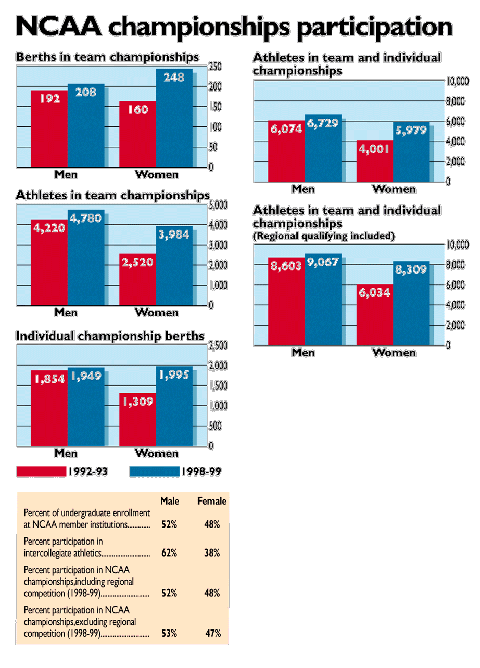
National Collegiate Athletic Association |
The NCAA News DigestJune 7, 1999
NCAA CHAMPIONSHIPS PARTICIPATIONData compiled for the Division I Championships/Competition Cabinet show progress that has been made over the last six years in making NCAA championships more gender equitable. The number of women's teams participating in NCAA championships has increased 55 percent over the last six years while the number of female athletes in team championship competition has grown by 57 percent. Similar gains were reported for women in individual-championship competition.
At all levels of NCAA championship competition, 48 percent of the participants are female.
BASKETBALLCrowds at men's tournament lead to attendance increase Because of an increase in postseason attendance and the addition of five new teams to Division I, national men's basketball attendance rose more than one-half million as 23,815,296 spectators attended games involving Division I teams during the 1998-99 season. It was the 11th consecutive year that Division I attendance topped the 23-million mark. Overall, a total of 31 new NCAA schools increased total attendance to 28,732,813 fans, up by 701,021 over last season. It was the second consecutive increase after four straight years of decline. The Big Ten Conference again set a new standard for conference attendance as 2,204,556 fans streamed through the turnstiles during the 1998-99 season for a 13,361 per-game average. The Big Ten had set the previous mark last season at 2,166,264. The Southeastern Conference claimed the second spot in 1998-99 with an average of 10,776 fans per game. The ACC was the only other conference to top the 10,000 per-game mark with 10,253. In Division II, Kentucky Wesleyan claimed its first attendance title with 4,247 spectators a game. Hope returned to the top spot as the Division III attendance leader with 2,440 spectators per game. Staff contact: Gary K. Johnson.
RULES COMPLIANCE1999 rules compliance guide to be mailed in mid-June The 1999 Guide to Rules Compliance will be mailed in mid-June to directors of athletics, campus compliance directors, conference commissioners and conference compliance directors. If an individual attended a regional rules compliance seminar this spring and received a guide at that time, he or she will not receive an additional copy. Each institution's director of financial aid will receive the NCAA Guide to Financial Aid. Each institution's director of admissions will receive the NCAA Guide to Eligibility. The chief executive officer, senior woman administrator and faculty athletics representative at each institution will be copied on the corresponding memos. Staff contact: Mira J. Colman.
SPORTS SCIENCESExpert concludes benefits of creatine are overstated Many athletes may expect more benefits from creatine than the dietary supplement can deliver, according to physiology professor who chaired a recent American College of Sport Medicine (ACSM) roundtable on creatine supplementation. "The expectations far outweigh the returns," said Ron Terjung of the University of Missouri, Columbia, who chaired the roundtable. The roundtable's opinions were to be shared at a June 5 meeting of the ACSM. An Associated Press story quoted Terjung as saying that researchers have found performance improvements in laboratory tests involving sudden bursts of very strenuous activity. However, Terjung said that the improvements are under very specific conditions and do not match up with what most athletes do. Terjung was quoted as saying that creatine's value as a training aid is uncertain. While the supplement clearly makes athletes bigger, he said that is because creatine makes them retain more water. Staff contact: Randall W. Dick.
LEGISLATIONMembership deadline approaching in Divisions II, III Divisions II and III institutions and conferences have until 5 p.m. July 15 to submit legislative proposals for the 2000 NCAA Convention. In Division II, the minimum number of active member institutions required to sponsor an amendment not sponsored by the NCAA Division II Presidents Council is 15. A proposal must be signed by the chief executive officer of a sponsoring institution or by the CEO's designee. CEOs must notify the national office in writing of individuals designated to sign a proposal. In the alternative, at least two chief elected or executive officers of a voting member conference (such as a conference commissioner) can submit legislation on behalf of 15 or more active conference members, as long as those sponsoring institutions are listed and the proposal is signed by the chair of the conference's official presidential administrative group (or by at least two CEOs of conference schools if no such group exists). In Division III, the minimum number of active member institutions required to sponsor an amendment not sponsored by the NCAA Division III Presidents Council is eight. A proposal must be signed by the chief executive officer of a sponsoring institution or by the CEO's designee. CEOs must notify the national office in writing of individuals designated to sign a proposal. Legislation also can be submitted by a chief conference officer on behalf of eight or more active conference members. Chief executive officers' signatures are required in the same manner as in Division II. Staff contact: David W. Schnase.
DIVISION IBasketball rules committee rescinds logo decision The Men's Basketball Rules Committee voted June 1 to rescind its previous action to authorize an NCAA basketball logo on jerseys. The action was rescinded because the committee concluded there was not a fully developed men's basketball marketing plan in place at this time. For that reason, it was premature to act on the issue at this time. Staff contact: S. David Berst.
|
